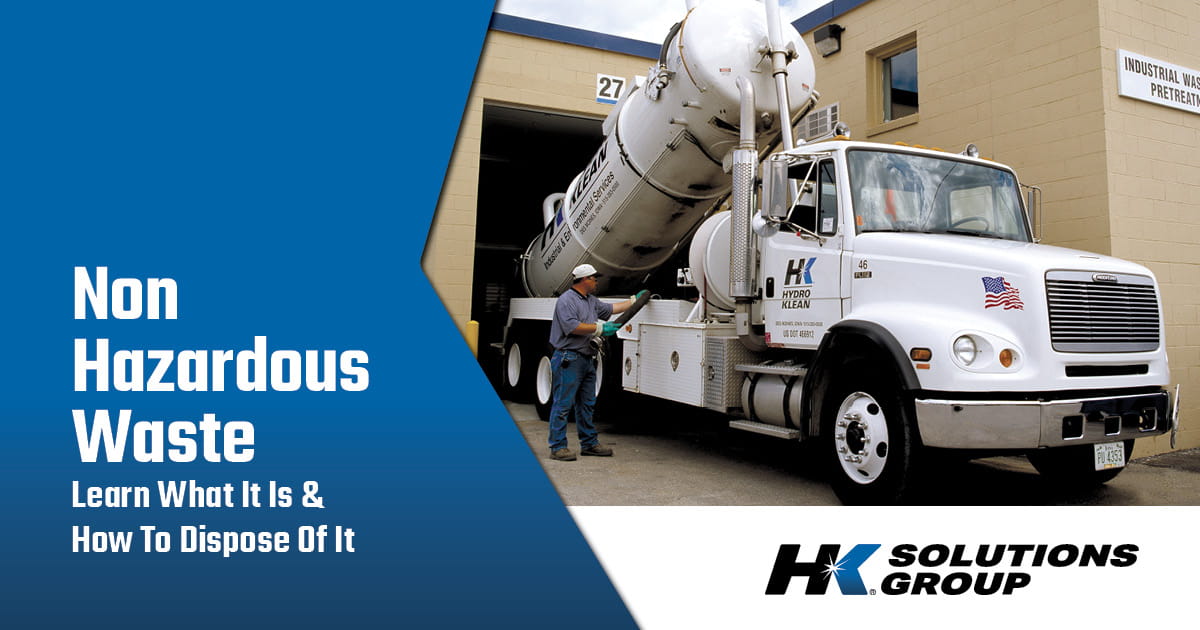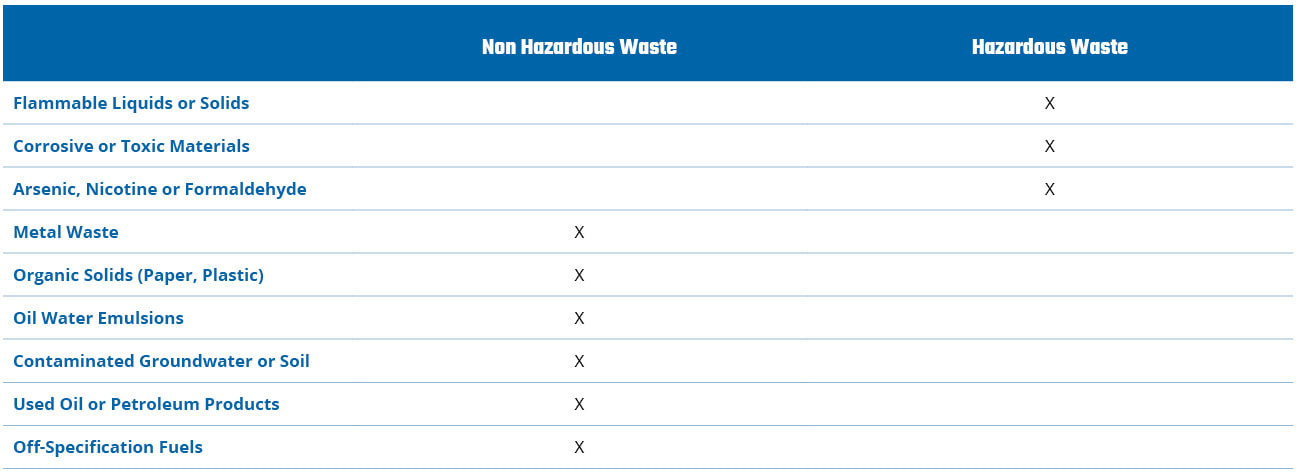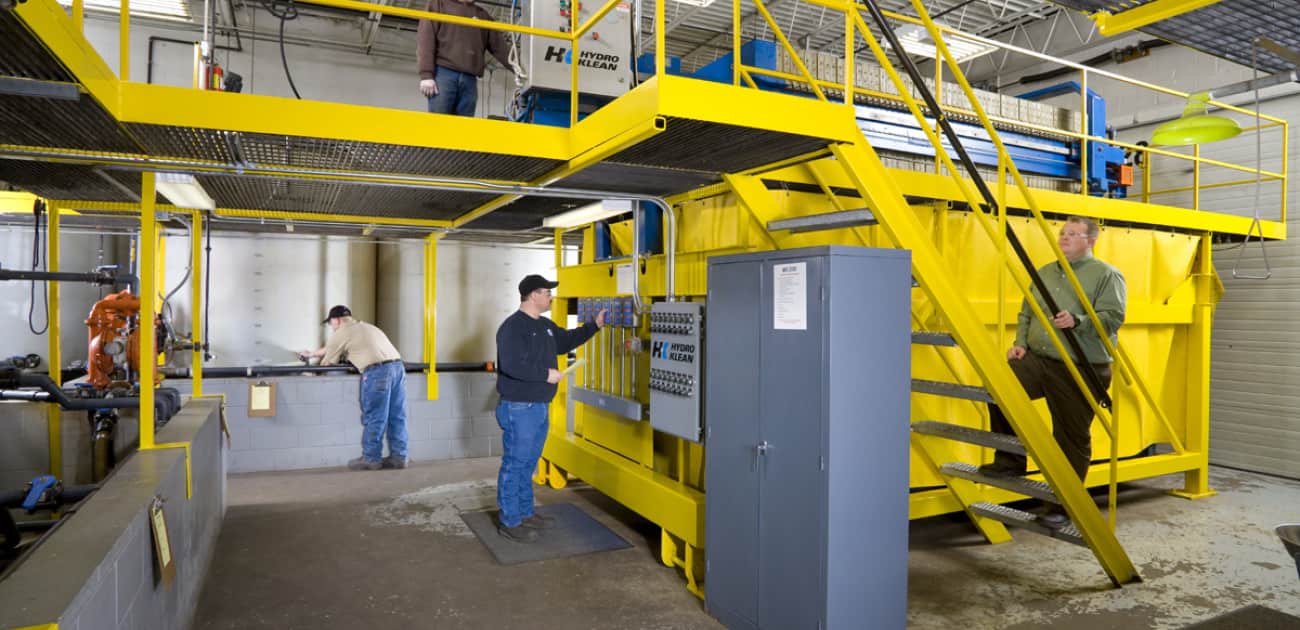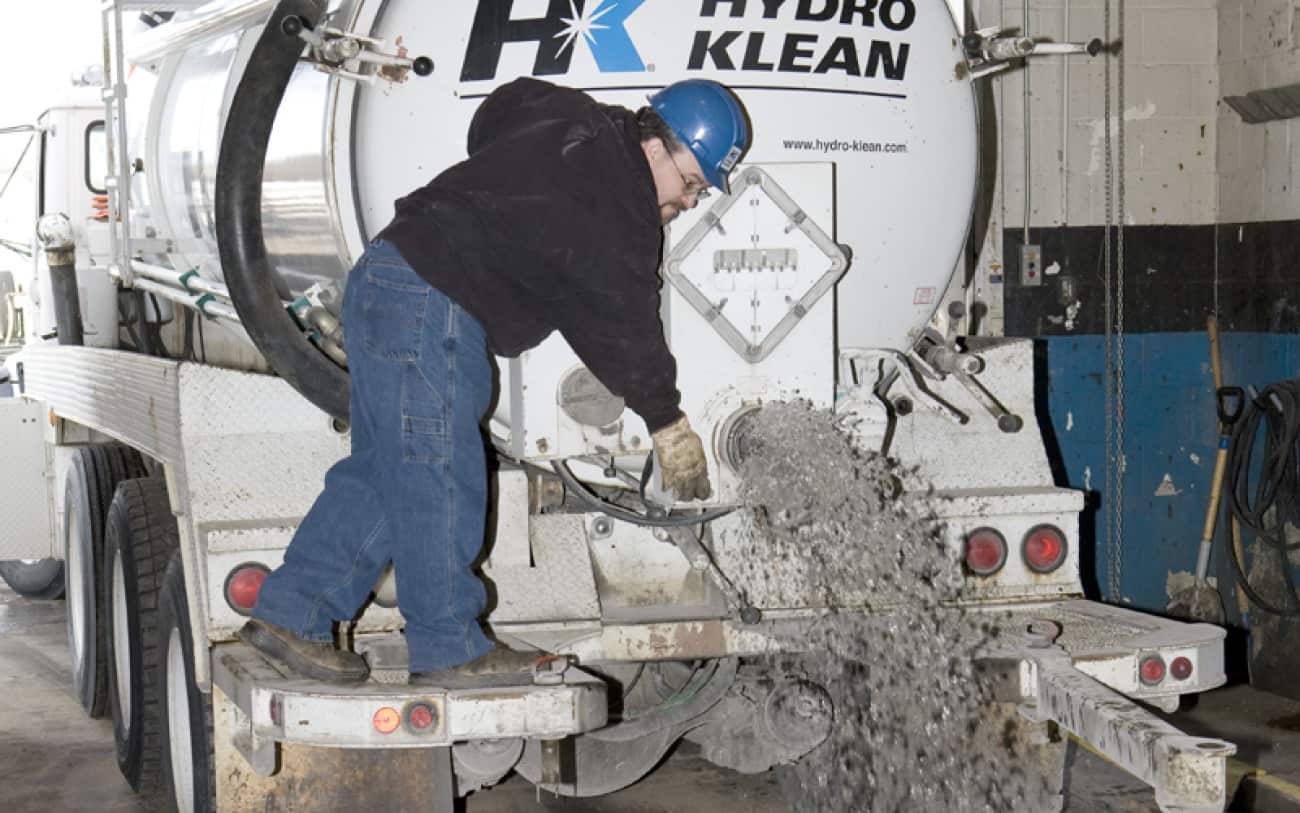Got Waste? What To Know About Industrial Non-Hazardous Waste
November 6, 2025

Every business produces some form of waste, but industrial facilities often face the burden of managing multiple waste streams. Hazardous waste is strictly regulated and often more recognizable—and rightly so—but industrial non-hazardous waste makes up the majority of waste at most facilities. To put it into perspective, the World Health Organization estimates 85 percent of waste from medical facilities is non-hazardous, and industrial facilities have a similar footprint. Yet non-hazardous waste regulations are very often misunderstood or ignored altogether due to lack of education and support for the proper disposal of non-hazardous waste materials.
Notably, non-hazardous industrial waste streams typically cost much less to dispose of compared to highly regulated hazardous waste, so understanding the needs for non-hazardous disposal opens your business up to cost savings, while still maintaining compliance.
What Is Industrial Non-Hazardous Waste?
Industrial non-hazardous waste is a classification for waste liquids and solids produced during industrial processes deemed at low risk for endangering individuals or the environment when discarded. Hazardous waste is typically toxic, corrosive or flammable and heavily regulated by the Environmental Protection Agency. Due to more relaxed non-hazardous waste regulations, your business can save time and money by understanding the difference and how to properly dispose of both.

Examples Of Non-Hazardous Waste
Examples of non-hazardous waste vary depending on the industry and production materials. Examples include oils, lubricants, metalworking coolants, contaminated groundwater, oil spill clean-up, metals-laden process water, sludges, organic materials like paper or plastic and more. Agricultural facilities, laboratories, manufacturing facilities, chemical processing plants, food processing plants and environmental remediation sites produce high volumes of non-hazardous industrial waste.
Centralized Waste Treatment Guidelines established by the Environmental Protection Agency include a comprehensive list of potential non-hazardous waste streams falling within the general metal, oil or organic materials categories constituting the majority of industrial non-hazardous waste. Examples of non-hazardous waste include, but are not limited to:
- Oil-water emulsions or mixtures
- Contaminated groundwater clean-up from petroleum sources
- Contaminated soil and petroleum-soaked absorbent materials
- Used oil or petroleum products
- Rinse waters from petroleum sources
- Interceptor wastes
- Off-specification fuels
- Underground storage tank remediation waste
- Tank cleanout from petroleum or oil sources
On the flip side, waste generated from specialized industrial processes is almost always classified as hazardous waste depending on the nature of the process. Some of these hazardous waste hotspots include metal finishing facilities, wood treatment facilities and pesticide production centers, as well as facilities working with explosives, veterinary medicine laboratories and wastewater generated by refineries. Toxins like arsenic, nicotine and formaldehyde in any application are strictly regulated from usage through proper disposal.
If you’re uncertain whether or not your waste streams are hazardous or non-hazardous, it’s always smart to submit samples for lab analysis to determine waste characteristics. After all, there are both hazardous and non-hazardous waste regulations in place to keep people and the environment safe.

Non-Hazardous Waste Regulations
The first step toward compliance is determining whether your industrial non-hazardous waste or hazardous waste streams are regulated according to the Code of Federal Regulations’ Identification and Listing of Hazardous Waste. Once a determination has been made, developing a strategic waste management plan to appropriately dispose of non-hazardous industrial waste and hazardous materials helps your facility stay in compliance with state and federal regulations as they pertain to your business.
A critical component of your waste management program is understanding how these state and federal rules regarding waste storage, handling and disposal impact your facility. For highly regulated hazardous waste, your generator status, as determined by the EPA, should dictate how your waste program is administered. While non-hazardous waste regulations are not enforced to the same strict standards as hazardous waste, it’s important that non-hazardous waste is documented, stored and handled using industry best practices established by waste experts trained in compliance. In doing so, you avoid citations, prevent fines (which reach a maximum of $93,000 per day per violation depending on the severity) and ensure your business is viewed as a good steward of the environment for your community.
Since many facilities don’t maintain waste management staff on site, it’s important to connect with a certified waste disposal company to coordinate waste classification and safe, compliant disposal of non-hazardous waste in a timely fashion. Disposal companies have the technology and training to identify waste streams and ensure materials go to the right place. Knowing the exact breakdown and characteristics of a waste profile prevents cross-contamination and assures compliance. If keeping up with disposal of non-hazardous waste gets in the way of your other important business procedures, businesses can call on professional waste service providers to provide ongoing planning, analysis, support and/or transportation to disposal facilities.
How To Dispose Of Non-Hazardous Waste
Non-hazardous waste regulations have strict classifications for what qualifies as non-hazardous versus hazardous waste, but once you’ve identified waste properties, there are a variety of disposal options available. If you’re confident in navigating how to dispose of non-hazardous waste and keep up with waste flow, you can coordinate disposal efforts or repurpose waste materials as you see fit. However, if it’s difficult for your facility to distinguish hazardous and non-hazardous industrial waste streams or you’re producing an overwhelming volume of waste, relying on the expertise of a trusted waste services provider ensures you remain compliant and maintain a safe, clean facility.
Check With Local Treatment, Storage & Disposal Facilities
Local treatment, storage and disposal facilities (TSDFs) often limit how much waste they accept at one time and require large quantities be delivered by a certified disposal company. If you’re considering handling waste transportation in-house, it’s a good idea to check with your local TSDF first to be sure they’ll accept your waste. Bulk waste shipments are best facilitated by a whose business focus is classifying and quantifying streams for the safe disposal of hazardous and non-hazardous waste.
Reuse & Recycle What You Can
Disposal of non-hazardous waste is only necessary if the waste materials serve no other purpose. Organic waste, especially, has the potential to be recycled rather than disposed of. This includes paper byproducts, fibers from textile production and scraps from food production facilities. Recycling industrial non-hazardous waste reduces your facility’s carbon footprint by lessening greenhouse gases emitted into the atmosphere. Check with local recycling centers to see if they’re able to give new life to your waste materials.
If items aren’t eligible to be recycled, savvy facilities can repurpose waste by converting it into renewable energy to help fuel operations. Some organic waste compounds, such as paper, plastic and wood, are safe to combust, using burning or high heat to convert solid waste into gas that, in turn, can be used to power heat or electricity for a facility. Facilities looking to reclaim energy costs by reusing waste must exercise caution to ensure the safe transformation of these materials. Not all non-hazardous industrial waste should be reused if it isn’t safe or effective to do so. In that same vein, hazardous waste should never be used to convert to energy because there is a high risk for flammability or for toxins to leak into the air.
Coordinate Treatment & Disposal With A Certified Provider
Hazardous and non-hazardous waste regulations leave no room for error. From the moment waste is produced on-site at a facility, the facility is liable for any harm it may cause. From correctly characterizing a waste stream and safely storing it prior to transport to ensuring it is disposed of properly, the burden falls on each individual business. Connecting with a certified treatment, storage and disposal facility allows access to highly trained technicians who are able to adeptly coordinate ongoing or one-time waste disposal plans.
HK Solutions Group’s 31,055 square feet industrial wastewater treatment plant in Des Moines is one of only two licensed disposal facilities in Iowa. Extending our services to a 200-mile radius from our facility, our experienced waste experts are equipped to handle disposal of non-hazardous waste from classification to transportation, treatment and disposal. Our waste management plans can be as involved as you need them to be. Whether you need on-site visits to ensure compliance, analysis to identify waste components, transportation to our disposal facility or all of the above, you’re in good hands with HK.
How HK Solutions Group Simplifies Disposal Of Non-Hazardous Industrial Waste
From following a routine schedule to help your facility maintain a compliant cadence of waste disposal to one-time emergency clean-ups, we handle every substance we encounter with the utmost care. Our facility treats oil and metal non-hazardous industrial waste with capabilities to manage up to 70,000 gallons of wastewater and 80 cubic yards of solid waste, as well as drum and bulk quantities for disposal. During treatment, waste is removed from wastewater streams so clean water can go back into the sanitary sewer system. Solid waste materials are disposed of or recycled as applicable.
With HK as your full-service industrial partner, we can also assist with the coordination of hazardous waste disposal through our many connections in the industry. You don’t need to waste precious working hours arranging for the upkeep and disposal of ongoing waste accumulation. We are ready to take disposal of non-hazardous waste off your hands. For safe, compliant, timely and cost-effective waste management, trust HK Solutions Group.

Does Your Facility Have Industrial Non-Hazardous Waste? Call HK To Set Up Waste Removal Services!
With a better understanding of industrial non-hazardous waste regulations and classifications, your facility has completed the first step toward a successful waste management plan. HK Solutions Group is happy to help execute a comprehensive plan all the way through the safe disposal of hazardous and non-hazardous industrial waste to set your business up for continued compliance in Iowa and beyond. Contact us to get started working with our dedicated waste technicians today.
Get Started With HK